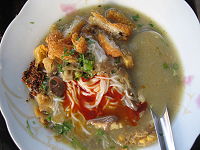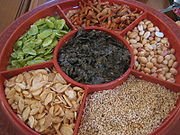
National symbols of Burma
Encyclopedia
The national symbols of Burma (also known as Myanmar) are icons, symbols and other cultural expressions which are seen as representative of the Burmese people. These have been accumulated over centuries and are mainly from the Bamar
majority, while other ethnic groups also maintain their own symbols. No official codification or de jure recognition exists, but most of these symbols are seen as de facto representative of the Burmese people. The use of much of these symbols were cultivated during the Konbaung dynasty which ruled Burma from 1761 to 1885.
. However, two flowers are seen as national symbols.
the best".
Bamar
The Bamar are the dominant ethnic group of Burma , constituting approximately two-thirds of the population. The Bamar live primarily in the Irrawaddy basin, and speak the Burmese language, which is also the official language of Burma. Bamar customs and identity are closely intertwined with general...
majority, while other ethnic groups also maintain their own symbols. No official codification or de jure recognition exists, but most of these symbols are seen as de facto representative of the Burmese people. The use of much of these symbols were cultivated during the Konbaung dynasty which ruled Burma from 1761 to 1885.
Flora
The Burmese ascribe a flower to each of the twelve months of the Traditional Burmese calendarTraditional Burmese calendar
The traditional Burmese calendar is a lunisolar calendar based on both the phases of the moon and the motion of the sun. Within each month of the Burmese calendar, a major festival, often Burmese Buddhist in nature, is held...
. However, two flowers are seen as national symbols.
| The padauk Pterocarpus macrocarpus Pterocarpus macrocarpus is a species of Pterocarpus native to southeastern Asia in northeastern India, Burma, Laos, Thailand, and Vietnam.... is referred to as the national flower of Burma and is associated with the Thingyan Thingyan Thingyan is the Burmese New Year Water Festival and usually falls around mid-April . It is a Buddhist festival celebrated over a period of four to five days culminating in the new year... period (Burmese New Year, usually mid-April). Unfortunately, it is often mistaken with the Cassia fistula (Ngu-wah), which is the national flower of Thailand. |
|
| The thazin Bulbophyllum auricomum Bulbophyllum auricomum is a species of orchid in the genus Bulbophyllum.-References:**... orchid is another important plant. According to a Burmese poem, during the Konbaung era, the king had the right to claim the first flowering bud of thazin within the realm and any transgression was punishable by death. |
Fauna
| The Green Peafowl Green Peafowl The Green Peafowl or Javan Peafowl, Pavo muticus is a large Galliform bird that is found in the tropical forests of Southeast Asia... , called the 'Daung' or U-Doung in Burmese, is one of the national animals of Burma. It is strongly associated with the Konbaung monarchy and the anti-colonial nationalist movements and thus is popularly seen as the symbol of the Burmese state. The Dancing peacock, Ka-Doung was used as the symbol of the Burmese monarch and was stamped on the highest denominator coins minted by Burma's last dynasty. Upon independence, it was again featured on Burmese banknotes from 1948 til 1966. The 'Dancing Peacock' also appeared on certain flags of the Konbaung dynasty Konbaung dynasty The Konbaung Dynasty was the last dynasty that ruled Burma from 1752 to 1885. The dynasty created the second largest empire in Burmese history, and continued the administrative reforms begun by the Toungoo dynasty, laying the foundations of modern state of Burma... , British Burma and also the State of Burma State of Burma The State of Burma was created in 1943 under Japanese occupation.-Background:During the early stages of World War II, the Empire of Japan invaded British Burma primarily to obtain raw materials , and to close off the Burma Road, which was a primary link for aid and munitions to the Chinese... which was a collaborationist Japanese client state during the Second World War. An alternative pose, to denote struggle, is the fighting peacock, Khoot-Daung as seen visibly on the party flag of Aung San Suu Kyi Aung San Suu Kyi Aung San Suu Kyi, AC is a Burmese opposition politician and the General Secretary of the National League for Democracy. In the 1990 general election, her National League for Democracy party won 59% of the national votes and 81% of the seats in Parliament. She had, however, already been detained... 's de jure disbanded National League for Democracy National League for Democracy The National League for Democracy is a Burmese political party founded on 27 September 1988. Nobel Peace Prize laureate Aung San Suu Kyi serves as its General Secretary. The party won a substantial parliamentary majority in the 1990 Burmese general election. However, the ruling military junta... . Due to the political connections, the peacock has been discarded in favour of the Chinthe by the military junta State Peace and Development Council The State Peace and Development Council was the official name of the military regime of Burma , which seized power in 1988. On 30 March 2011, Senior General Than Shwe signed a decree to officially dissolve the Council.... which ruled Burma after 1988. |
|
| The Chinthe Chinthe The Chinthe is a leogryph that is often seen at the entrances of pagodas and temples in Burma and other Southeast Asian countries. The chinthe is featured prominently on the kyat, the currency of Burma. The chinthe is almost always depicted in pairs, and serve to protect the pagoda... , a leogryph found mainly in front of pagodas and temples, have been promoted by the previous military government State Peace and Development Council The State Peace and Development Council was the official name of the military regime of Burma , which seized power in 1988. On 30 March 2011, Senior General Than Shwe signed a decree to officially dissolve the Council.... as the symbol of state. The Chinthe had been used as a symbol of state, mainly as a supporting figure to the peacock, after independence, but it became more prominent only after 1988 - when it began to appear on almost all denominations of Burmese banknotes and coins (1999). The main throne of the later Konbaung dynasty was the Golden Lion Throne. |
|
| The white elephant White elephant A white elephant is an idiom for a valuable but burdensome possession of which its owner cannot dispose and whose cost is out of proportion to its usefulness or worth... is another symbol of state associated with the days of the monarchy. Like in neighbouring Thailand, the white elephant is revered as a blessing towards the entire country. The importance of the white elephant to Burmese and Theravada culture can be traced to the role which white elephants play in Buddhist cosmology and the Jatakas. Hsinbyushin Hsinbyushin Hsinbyushin was king of the Konbaung dynasty of Burma from 1763 to 1776. The second son of the dynasty founder Alaungpaya is best known for his wars with China and Siam, and is considered the most militaristic king of the dynasty. His successful defense against four Chinese invasions preserved... , a king of the Konbaung dynasty Konbaung dynasty The Konbaung Dynasty was the last dynasty that ruled Burma from 1752 to 1885. The dynasty created the second largest empire in Burmese history, and continued the administrative reforms begun by the Toungoo dynasty, laying the foundations of modern state of Burma... , even went to the extent of conquering Thailand and sacking Ayutthaya Ayutthaya kingdom Ayutthaya was a Siamese kingdom that existed from 1350 to 1767. Ayutthaya was friendly towards foreign traders, including the Chinese, Vietnamese , Indians, Japanese and Persians, and later the Portuguese, Spanish, Dutch and French, permitting them to set up villages outside the walls of the... in order to obtain white elephants - his name itself means 'Lord of the White Elephant'. |
Food
A popular saying states "A thee ma, thayet; a thar ma, wet; a ywet ma, lahpet" , translated as "Of all the fruit, the mango's the best; of all the meat, the pork's the best; and of all the leaves, lahpet'sLahpet
Lahpet, also spelt laphet :"Of all the fruit, the mango's the best; Of all the meat, pork's the best; Of all the leaves, lahpets the best".-Etymology:...
the best".
 |
Mohinga Mohinga Mohinga is Rice noodles in fish soup and considered by many to be the national dish of Burma. It is readily available in most parts of the country. In major cities, street hawkers and roadside stalls sell dozens of dishes of mohinga to the locals and passers-by... is the de facto national dish of Burma. It is a rice noodle dish served with thick fish broth and is generally eaten for breakfast. The main ingredients of the broth are catfish, chickpea flour, lemongrass, banana stem, garlic, onion, ginger and ngapi Ngapi Ngapi is a generic term for pungent pastes made of either fish or shrimp in Myanmar. It is usually made from the fermentation of salted ground fish or shrimp, which is then sun dried. Ngapi is a main ingredient of Lower Burmese cooking, used as a condiment and additive in most dishes... . |
 |
Laphet thoke is another symbolic dish of Burma, albeit a snack. It consists of pickled tea leaves soaked in oil eaten with an assortment of fritters including roasted groundnuts, deep fried garlic, sun dried prawns, toasted sesame and deep fried crispy beans. Laphet is served in a traditional 'oat' - a lacquer container with individual compartments for each ingredients. Lahpet was an ancient symbolic peace offering between warring kingdoms in the history of Myanmar, and is exchanged and consumed after settling a dispute. |
Sport
| Chinlone Chinlone Chinlone is the traditional sport of Burma . Chinlone is a combination of sport and dance, a team sport with no opposing team. In essence chinlone is non-competitive. The focus is not on winning or losing, but how beautifully one plays the game.... is the national sport of Burma. A non-competitive sport, the game focuses on players attempting to exhibit moves designed to prevent the ball from touching the ground, without using their hands. Mandalay Mandalay Mandalay is the second-largest city and the last royal capital of Burma. Located north of Yangon on the east bank of the Irrawaddy River, the city has a population of one million, and is the capital of Mandalay Region .... is a major centre for playing and learning chinlone. |
Musical instrument
| The Saung Saung The saung is an arched harp used in traditional Burmese music. The saung is regarded as a national musical instrument of Burma. The saung is unique in that it is a very ancient harp tradition and the only surviving harp in Asia today.- Description :... or Burmese harp, is the national musical instrument of Burma. Although not used much in modern music, it is seen as the epitome of Burmese culture. It is the only surviving harp in Asia. |
See also
- Mythical creatures in Burmese folkloreMythical creatures in Burmese folkloreA wide variety of mythical creatures are found in Burmese folklore and in mythology. Many Burmese creatures are part human or creatures capable of assuming human form...
- Burmese dance
- Cuisine of Burma
- Music of Burma
- LongyiLongyiA longyi is a sheet of cloth widely worn in Burma. It is approximately 2 m long and 80 cm wide. The cloth is often sewn into a cylindrical shape. It is worn around the waist, running to the feet. It is held in place by folding fabric over, without a knot. It is also sometimes folded up to...

